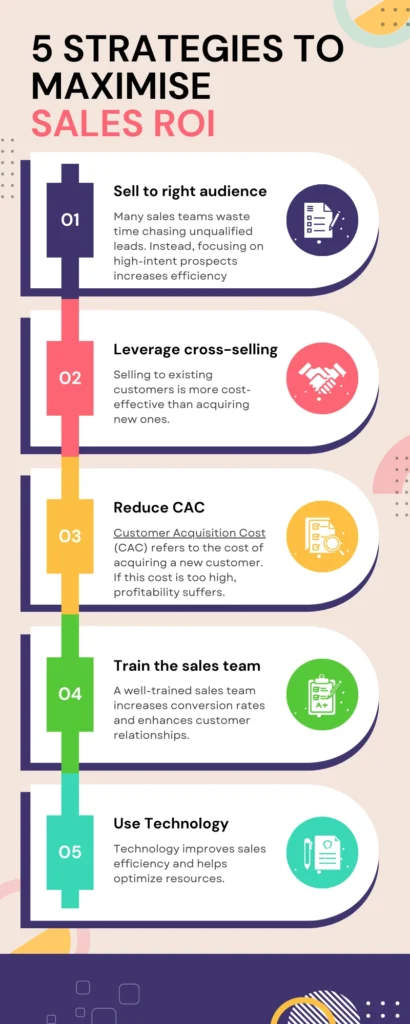Table of Contents
Vinod: The Ninja Warrior Who Missed the ROI Trick
Let’s understand ROI with an interesting story from my days at Sharekhan Education. Back in 2017-18, at Sharekhan Education, we had free workshops as the only sales strategy. We would generate leads online, invite them for a free session, and then pitch our paid education courses. Simple, effective, and highly scalable.
No one executed this strategy better than Vinod, our Sales Head from Chennai. His team consistently had the highest conversion rates, and the rest of us, including myself, often admired his outstanding performance. He was like a ninja warrior of sales, always achieving his targets with precision.
However, the post-COVID reality changed everything. The cost per lead increased nearly four times, making Vinod’s once-profitable workshops financially unviable. Even with his exceptional conversion skills, the numbers no longer made sense. He was spending ₹3 lakh to generate ₹3 lakh in revenue. At times, the total cost of running the workshops exceeded the revenue earned.
It was difficult to see a great closer struggle simply because he did not adapt to the changing dynamics. He could have leveraged referrals, optimized his data, and used local presenters to reduce costs. Despite his skills, the lack of awareness made his workshops unsustainable.
This story highlights an important lesson. Sales success is not just about closing deals but it is also about ensuring that every effort and investment leads to a positive return.

Understanding ROI in Sales
ROI, or Return on Investment, is calculated using the formula:
ROI = (Revenue – Cost) ÷ Cost × 100
For example, if a company spends ₹1 lakh on marketing and sales activities and generates ₹5 lakh in revenue, the ROI is:
(5,00,000 – 1,00,000) ÷ 1,00,000 × 100 = 400%
A higher ROI indicates efficiency, while a lower one suggests the need for improvement.

Strategies to Maximize Sales ROI
Sell to the Right Audience
Many sales teams waste time chasing unqualified leads. Instead, focusing on high-intent prospects increases efficiency.
Successful strategies include inbound sales techniques to attract the right leads and data analytics to track buyer behavior.
For example, a financial advisor targeting young professionals earning ₹10–15 lakh per year will achieve better results than one pitching to college students with no disposable income.
Leverage Upselling and Cross-Selling
Selling to existing customers is more cost-effective than acquiring new ones.
Cross-selling involves offering complementary products or services, such as insurance with mutual funds. Upselling encourages customers to upgrade their purchases, such as increasing an investment amount from ₹5 lakh to ₹10 lakh for better returns.
Companies like Amazon generate over 35% of their revenue from cross-selling, proving its effectiveness.
Reduce Customer Acquisition Cost
Customer Acquisition Cost (CAC) refers to the cost of acquiring a new customer. If this cost is too high, profitability suffers.
Businesses can lower CAC by leveraging referrals and word-of-mouth marketing, automating sales processes using CRM tools, and focusing on customer retention. Research shows that increasing retention by 5% can boost profits by up to 95%.
For example, instead of relying on expensive advertisements for a sales workshop, businesses can use LinkedIn and email marketing to reach past participants at a lower cost.
Train the Sales Team for Maximum Efficiency
A well-trained sales team increases conversion rates and enhances customer relationships.
Effective training should focus on listening skills, structured sales scripts, and role-playing real-life scenarios. A financial advisor who can clearly explain risk versus reward is more likely to convert a hesitant prospect into a lifelong client.
Use Technology to Scale Sales
Technology improves sales efficiency and helps optimize resources.
Tools like CRM software track customer interactions and automate follow-ups. AI-powered chatbots qualify leads instantly, and LinkedIn Sales Navigator helps sales teams target decision-makers effectively.
One of my Mumbai-based real estate agent friends increased sales by 40% by using WhatsApp automation for lead nurturing without hiring additional staff.
Conclusion
Maximizing success in sales is not just about increasing revenue. It is about optimizing costs, time, and resources to improve overall profitability. Whether selling financial services, real estate, or training programs, efficiency is the key to sustainable success.
Focusing on the right audience, leveraging upselling and cross-selling, reducing acquisition costs, training the sales team, and using technology can significantly enhance sales success. By implementing these strategies, businesses can ensure that every rupee invested in sales generates maximum returns.

Frequently Asked Questions
Question 1: What is the ROI formula?
Answer: The formula stands for Return on Investment. It is a financial metric used to measure the profitability or efficiency of an investment. The formula is: ROI = (Net Profit / Cost of Investment) x 100. Please note that this formula can be applied to various types of investments, including sales initiatives, marketing campaigns, and business projects.
Question 2: What is a good ROI to have?
Answer: The ideal ROI to have varies depending on the industry and specific business goals. However, a good ROI generally ranges between 10% to 20%. It is important for businesses to continuously strive for improvement and aim for a higher ROI to maximize profitability and efficiency
I have suggested a few of my relevant posts, keeping your interest in maximizing ROI in mind. Read them too for comprehensive understanding.
Inside sales: Get it right or get left behind
Maximise results through effective sales review meetings
Master 10 essential sales techniques for professional success
Chanakya niti for sales titans: 15 lessons for unstoppable success
For more insights on sales, marketing, and professional growth, visit AsPerVikas.com


Leave a Comment